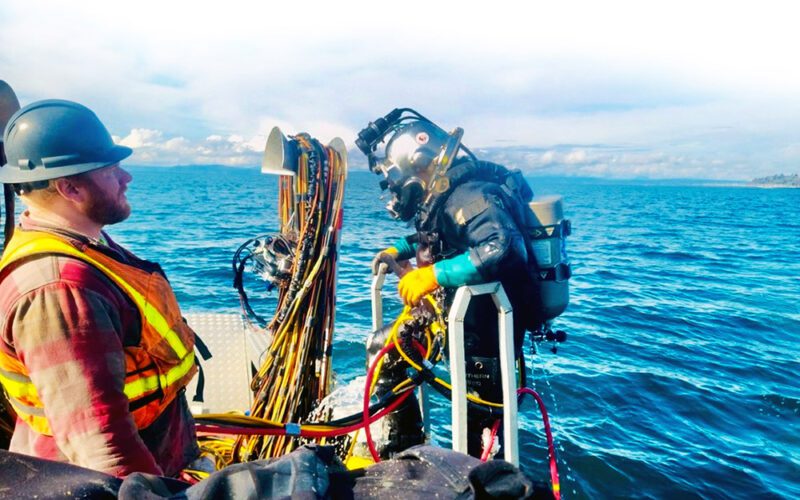While a lot of the work in the maritime industry happens above the water’s surface, often the jobs that take mariners underwater can be particularly tricky. But many of today’s professional divers are proficient in a variety of underwater tasks, including construction and engineering work, vessel salvage jobs, environmental projects and ship repairs.
Pacific Maritime reached out to companies along the West Coast that offer diving and salvage services to find out about some of their recent projects.
Power Engineering
Alameda, Calif.-based Power Engineering Construction (PEC) has a long history of tackling complex jobs “where the risk is high, the timing is critical and the success and safety of the work depend primarily on pre-planning and pre-engineering,” according to the company.
Power engineering offers full-scale diving operation services for underwater construction and repair projects of all types.
Currently the company’s dive team, certified by the Association of Diving Contractors International (ADCI), is engaged in a project to rehabilitate the structural support system of two 950-foot-long parallel seawater intake pipelines in an area situated within a national marine sanctuary along the Pacific coast.
Power Engineering’s team is utilizing two methods to accomplish this particularly sensitive task, each determined by sea-floor geology.
One method, where the substrate is predominantly rock (five to 20 feet below sea level), existing concrete block supports are retrofit in place and attached to the underlying granite seafloor. The other area consists of a sand bed zone (20 to 55 feet below sea level) and the existing concrete blocks are being removed and replaced with a socketed pipe and cross beam system.
In an email to Pacific Maritime magazine, Power Engineering officials explained that the work is highly monitored and measured to ensure protection and preservation of aquatic species and their habitats while construction takes place on the sea floor at depths ranging from five to 55 feet below sea level. There have been zero environmental incidents so far, they said.
Currently, the team is advancing through the installation of the socketed pipe and cross beam system, facing the challenge of navigating through up to eight feet of sand and an additional two to three feet of cobble to unveil the bedrock of granite.
Divers are achieving this by using a circular cofferdam as a pivotal tool: it holds back the encroaching sand and rubble during the excavation phase and allows the team to meticulously secure the posts that will underpin the crossbeam system.
Reaching the granite rock armed with a 20,000-psi water blaster and custom-designed template, divers cut through the unyielding rock, forging a path for the subsequent installation. The heart of the system comes to life as 4-inch by 13-foot-long AL-6XN posts are carefully socketed into place. This metal alloy, renowned for its exceptional corrosion resistance, embodies the project’s aspiration for longevity, geared towards a remarkable 100-year lifespan.
Without missing a beat, the dive team secures the posts, utilizing Denso FX225 grout infused with pea gravel to impart additional robustness. PEC officials commented that the divers’ dedication to finding creative solutions in challenging underwater conditions showcases both their use of advanced technology and skills.
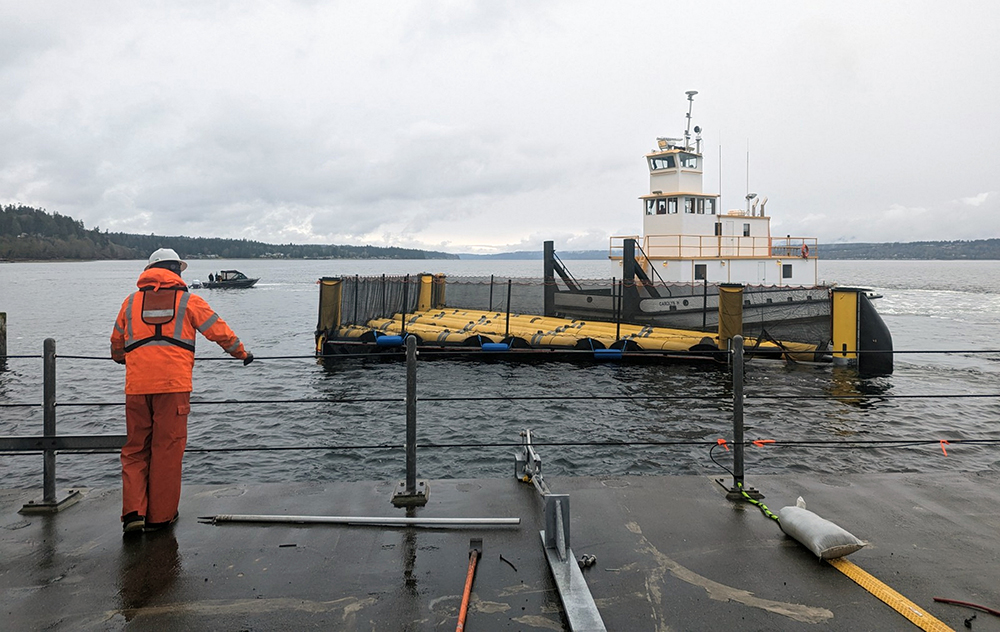
Global Diving & Salvage
With decades of experience managing complex, critical and technical projects in and around the water, Seattle-based Global Diving & Salvage is skilled at finding safe and effective solutions to complex problems—even under the most difficult conditions. Global Diving, which is owned by Massachusetts-based Moran Environmental Recovery, offers a variety of underwater services.
The company recently teamed up with Long Live the Kings (LLTK), a Pacific Northwest-based ecological nonprofit, for a fish-passage project with the hopes of guiding steelhead and salmon to survival in Washington.
The state’s salmon and steelhead populations have faced a severe challenge in recent years due to a major impediment to their natural migration path, the Hood Canal Bridge. According to the National Oceanic and Atmospheric Administration, up to 50% of juvenile steelhead fail to survive their journey past this bridge; addressing this issue has become imperative.
Global Diving, in collaboration with LLTK and working on behalf of the Hood Canal Bridge Assessment Team, was part of a creative solution to this issue, officials noted in an email to Pacific Maritime. Global played a critical role in facilitating the fabrication, deployment and testing of a large structure which has been named “the fillet.”
Boyer Logistics Inc. permitted Global to construct the fillet in their yard, while Pacific Netting Products handled the fabrication, shop built the structure and deconstructed it. The unique structure was engineered by Kleinschmidt Associates and Art Anderson Associates as a guide to help lead the fish away from the areas of the bridge where the juvenile fish tend to become disoriented, making them easy prey.
The fillet is a custom fabrication that stands nearly 20 feet tall and weighs more than 7,000 pounds. Lifting and placing the large structure into the water was a complex process. Due to the nature of the materials used to construct the fillet, moving it required more than 20 lifting points to ensure there was adequate support. Once in the water, Boyer Towing then towed the fillet to the bridge.
At the bridge, Global deployed the fillet for “block testing,” where it was temporarily attached to the bridge. Global’s dive team worked on a cadence of deploying the fillet for a time, then removing it and taking it off site. This acted as a baseline for the research team by allowing them to compare the fish’s behavior and survival with and without the fillet in place, Global officials explained.
Working on the Hood Canal Bridge presented its own set of challenges. Global’s dive team had to contend with aggressive tides and adverse weather conditions. The company implemented safety measures to ensure that the project progressed smoothly and without incident, securing the safeguarded the bridge’s structural integrity. Officials noted that Global’s expert team overcame the difficult conditions and completed all installations and removals.
This demonstration of adaptability was key in ensuring timely execution. The crew completed all work without any damage to the bridge, according to Global Diving.
“This project and ongoing testing represent a significant step toward achieving a more sustainable and harmonious coexistence between essential infrastructure and the natural ecosystems they intersect,” Global officials noted.
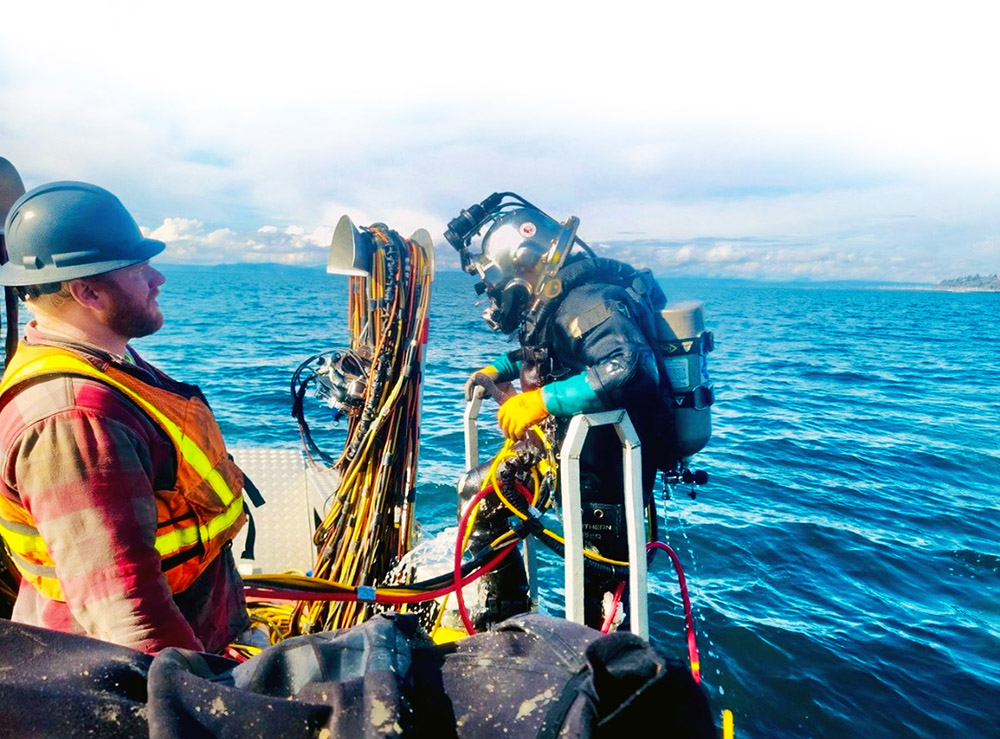
Associated Underwater Services
Associated Underwater Services (AUS), which is headquartered in Spokane, Wash. but also has offices in Kenmore, Wash. and Northern California, has extensive experience throughout the western U.S. in diving, underwater construction and remotely operated vehicle services. Originally founded in 1988, Nanci and Kerry Donohue took the helm and reorganized the company in 2001.
AUS continues to stay busy with a variety of recent jobs. Early this year the firm provided underwater diving services for Pacific Pile & Marine on projects at Pier 55 and Pier 56 in Seattle.
In tackling the projects, the company provided a three-person commercial diving crew approved by the Occupational Safety and Health Administration, Washington Industrial Safety and Health Act and ADCI. In an email to Pacific Maritime, AUS officials said that the diving crew performed pile excavation, pile cut offs, pile stubbing and general diving services.
The specific services included underwater educating, jetting and airlifting equipment, underwater hydraulic chainsaws and underwater welding and burning. The tasks were conducted at depths up to 45 feet.
AUS also recently worked on the Port of Seattle’s Terminal 5 modernization project, which represents a more than half-billion dollar investment by Northwest Seaport Alliance and private partners to increase Seattle’s international container capacity.
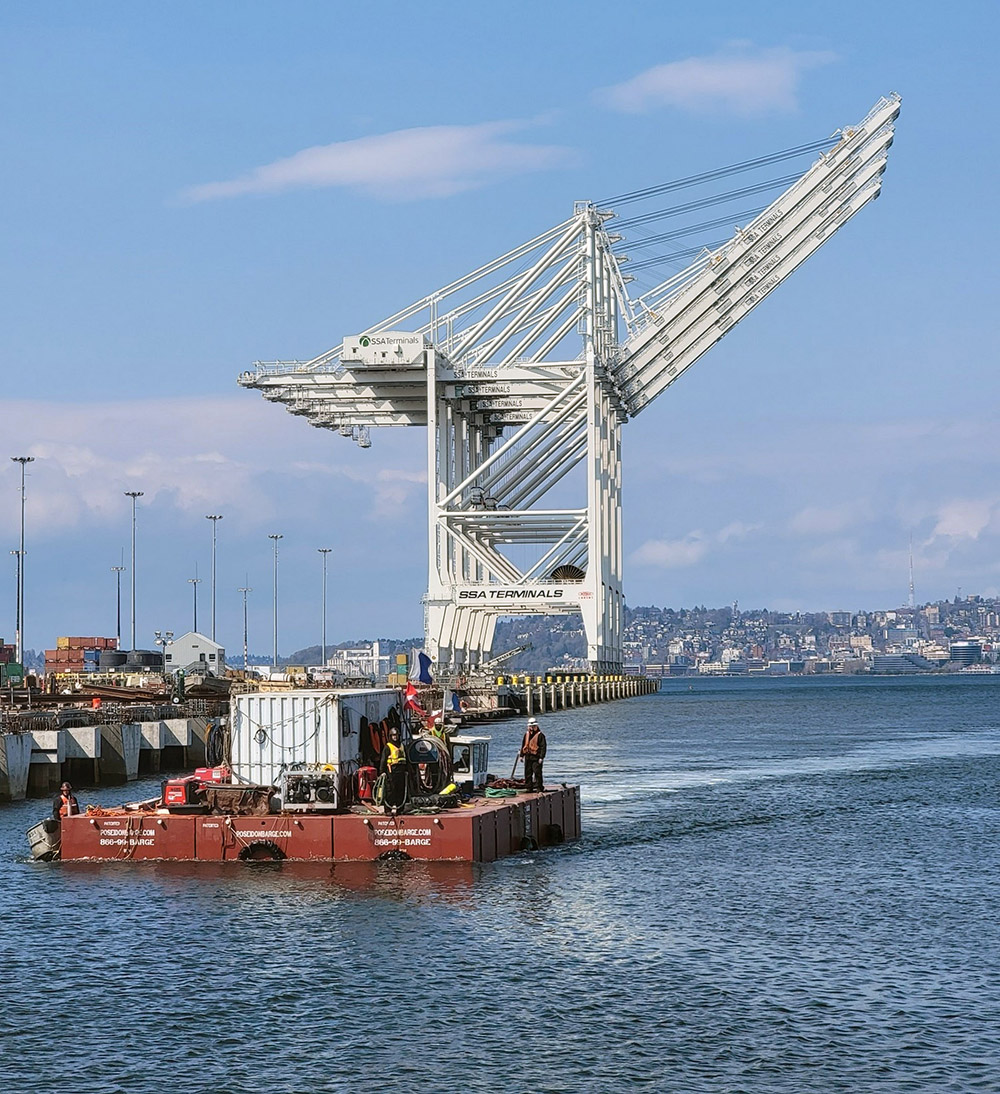
The company provided diving services for the terminal berth modernization and installed a new cathodic protection system. Services included driving steel sheet piles to grade, cutting timber and steel piles, cutting king piles to grade and installing a new cathodic protection system. Underwater welding and dredging were required to complete installation of piles. Every weld was videotaped via dive helmet and provided to the client, AUS officials noted.
Associated Underwater Services divers also recently worked on an emergency salvage job at Seattle’s Pier 69.
After a construction barge broke loose at the pier, AUS was called to provide emergency salvage services to locate and recover construction materials that fell from the barge. AUS crews also inspected the pier face to check for damage the loose barge may have caused.
Dive depths reached about 50 feet and high-pressure surface supplied breathing air was used. All construction materials were salvaged and returned. All dive operations were conducted with cameras mounted on divers’ helmets, allowing for topside monitoring.
This past March, AUS also worked on a notable vessel salvage.
Dive crews from the company assisted with salvaging the 45-foot Morning Star in Blind Bay, Wash. The vessel, built in 1948, was salvaged by the AUS team using floatation bags, rigging and trash pumps.
Inland, Associated Underwater Services divers also recently inspected and repaired damage to essential fish structures caused by storms on the Lewis River at the Swift Reservoir in Washington.
The crews inspected the damage and made necessary repairs to the Swift Fish exclusion net, Swift FSC NTS (net transition structure) and the Yale Fish exclusion net. In some cases, AUS divers needed to weave damaged areas of the nets back together.
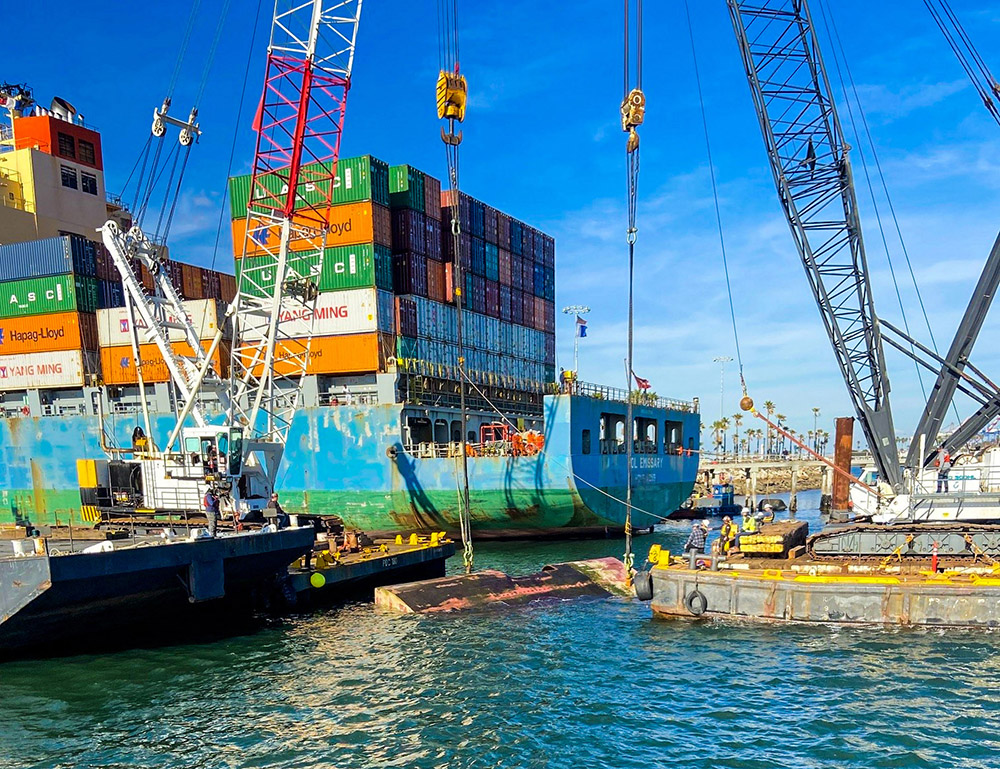
Pacific Maritime Group
Some marine salvage jobs require specialized equipment, along with experience and know-how in order to complete the project safely and efficiently.
San Diego-based Pacific Maritime Group has decades of salvage wreck removal experience with many tons of dead weight including sunken vessels, barges and some very unique structures.
In May, the fishing vessel Scorpion sank and broke up, scattering pieces along the California coastline, and Global Diving spearheaded efforts to clean it up. Due to the rugged nature of the shoreline and sensitive flora at nearby Point Fermin Park in Los Angeles, the pieces were gathered by hand.
Pacific Maritime Group came in with its barge, PTS-185, to help with the salvage process. Sunken pieces of the vessel were tagged, had lines attached, and were hoisted by helicopter to PMG’s barge.
The tug Hidalgo shadowed the cleanup efforts to minimize airtime, PMG Vice President of Business Development Robbie Adair explained in an email. When all pieces, bags and parts were aboard the barge, it was towed to Preferred Transport Systems’ warehouse in Long Beach, where they were craned off for disposal.
PMG also was involved in an underwater project that had little to no room for error. The company responded to a job in Long Beach where the rudder shaft on a containership had snapped. Oceanwide Repairs tackled the job and contracted Subsea Global Services to inspect the rudder and find a way to attach lifting points (steel rods inserted horizontally through the vertical blade).
With the bottom-heavy rudder not allowing for easy hoisting—along with the ship being loaded—the rudder was fully submerged. This made the difficult work even more challenging, Adair explained. As the rudder shaft had broken, the rudder itself was in a precarious position. It had to be rigged in a way that lent careful control in its lift so it would not accidentally strike the ship itself, he noted.
Pacific Maritime Group, which joined the complicated project as a subcontractor, first had to lift the rudder, which weighs upward of 130 tons, underwater. This entailed picking the rudder, despite it not being visible from the surface, and then swinging it “ever so gently” away from the ship before bringing it up out of the water, Adair said. PMG used two crane barges, PTS 180 and DB San Diego, for the job.
While carefully, slowly and safely maneuvering underwater, the DB San Diego lifted the rudder and swung it away from the ship. The PDC 180 was added and together they lifted the rudder, brought it horizontal and set it flat upon the barge PTS-150-R.
The rudder was taken to Long Beach, where it was craned ashore. There, it was raised and propped up for repair.
PMG also has been dispatched to help with a few unusual projects.
Late last year, it recovered an U.S. Navy fighter jet that overshot the runway at take-off at North Island Naval Station in Coronado, Calif. and came to rest in the water. In another incident earlier this year, PMG joined Phoenix International divers to search for a downed aircraft’s flight recorder, aka black box.
The device was located roughly seven miles south of the Farallon Islands, off the coast of San Francisco. The team found it using a towed “pinger” locator, TPL-25, which can locate pingers at depths up to 20,000 feet.
Sara Hall has 15 years of experience at several regional and national magazines, online news outlets, and daily and weekly newspapers, where coverage has included reporting on local harbor activities, marine-based news, and regional and state coastal agencies. Her work has included photography, writing, design and layout.

